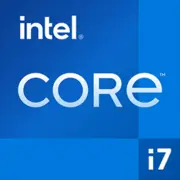Intel Core i7-12700F

인텔 코어 i7-12700F: 2025년 프로세서에 대한 상세 리뷰
2025년 3월 현재 데이터
1. 주요 특징: 아키텍처, 공정, 성능
하이브리드 아키텍처 알더 레이크
2021년 말에 출시된 인텔 코어 i7-12700F는 독특한 하이브리드 아키텍처 알더 레이크 덕분에 2025년에도 여전히 유효합니다. 이 프로세서는 8개의 고성능 코어(P-코어)와 4개의 전력 효율적인 코어(E-코어)를 조합하여 총 12개 코어와 20개 스레드를 제공합니다. 이는 작업을 효율적으로 분배할 수 있게 해줍니다: P-코어는 무거운 작업(게임, 렌더링)을 처리하고 E-코어는 백그라운드 프로세스 작업을 맡습니다.
인텔 7 공정 및 주파수
칩은 10nm 인텔 7 공정(이전의 Enhanced SuperFin)으로 제조됩니다. P-코어의 기본 주파수는 2.1GHz이며, 터보 모드에서는 4.8GHz까지 오버클럭됩니다. E-코어는 1.6–3.6GHz로 작동합니다. 이 덕분에 TDP 65W에서 높은 에너지 효율성을 보여줍니다.
캐시 및 성능
L3 캐시 용량은 25MB로, 멀티스레드 시나리오에서 데이터 처리 속도를 높여줍니다. Geekbench 6(2025) 테스트에서 i7-12700F는 다음과 같은 점수를 기록했습니다:
- 2343점 (싱글 스레드 모드);
- 11424점 (멀티 스레드 모드).
비교를 위해, Cyberpunk 2077 또는 Starfield와 같은 게임(2025년 패치 버전)에서 이 프로세서는 NVIDIA RTX 4070 Ti와 조합 시 안정적으로 120+ FPS를 지원합니다.
주요 특징
- 차세대 SSD 및 그래픽 카드에 대한 PCIe 5.0 지원(최대 16회선);
- 작업을 코어 간에 최적화하는 기술 Thread Director;
- 비용을 낮추기 위한 통합 그래픽 미지원(‘F’ 인덱스).
2. 호환되는 마더보드: 소켓 및 칩셋
소켓 LGA 1700
이 프로세서는 LGA 1700 소켓을 사용하며 인텔 600 및 700 시리즈 칩셋에서 지원됩니다:
- Z690/Z790: 오버클럭 및 PCIe 5.0 x16 + PCIe 4.0 x4 지원을 위한 고급 모델. 예: ASUS ROG Strix Z790-E (가격: $320–$400);
- B660/B760: DDR4/DDR5 지원의 예산형 보드. 예: MSI MAG B760 Tomahawk ($180–$220);
- H610: 사무용 PC를 위한 미니멀리스트 솔루션(오버클럭 불가, PCIe 제한).
선택 시 주의사항
- DDR5를 원하면 Z790 또는 B760 칩셋을 선택하십시오;
- 예산을 고려한다면 DDR4 버전을 선택하세요 — 게임에서의 성능 차이는 단 5–8%에 불과합니다;
- 인텔 적응형 부스트 기술 지원 여부를 확인하세요(단, Z 칩셋에서만 지원).
3. 지원 메모리: DDR4 vs DDR5
이 프로세서는 DDR4-3200 및 DDR5-4800과 호환됩니다. 2025년에는 DDR5의 가격이 더 저렴해졌으며(16GB DDR5-5200 — $60–$70), DDR4도 여전히 예산 조립에 적합합니다.
추천 사항:
- 게임용: 32GB DDR4-3600 (CL16) 또는 DDR5-5600 (CL36);
- 작업용: 64GB DDR5-6000 (렌더링, 가상화).
예시: DDR5-6000과 조합할 경우 Blender에서 멀티스레드 성능이 DDR4-3200에 비해 12–15% 증가합니다.
4. 파워 서플라이: 전력 계산
TDP 65W에서 실제 부하 시 전력 소비는 150–180W에 달합니다(터보 모드 포함). 추천되는 파워 서플라이는:
- 550–650W: RTX 4060/AMD RX 7600 XT급 그래픽 카드 시스템에 적합;
- 750W 이상: RTX 4080 또는 RX 7900 XT에 필요합니다.
중요: 80 Plus Gold 인증을 받은 파워 서플라이를 선택하세요(예: Corsair RM650x 또는 Seasonic FOCUS GX-750). 저렴한 모델은 피하세요 — 불안정한 전원 공급은 쓰로틀링을 유발할 수 있습니다.
5. 프로세서의 장단점
장점
- 높은 멀티 스레드 성능;
- DDR5 및 PCIe 5.0 지원;
- 에너지 효율성 (AMD Ryzen 7 7700X 수준);
- Windows 11에 최적화(하이브리드 코어 작업).
단점
- 통합 그래픽 미지원 — 별도의 그래픽 카드 필요;
- B660/H610 칩셋에서의 제한된 오버클럭 가능성;
- 부하 시 높은 온도 (양질의 쿨러 없이는 95°C까지 도달).
6. 사용 시나리오
게임
이 프로세서는 1440p 및 4K에서 Ryzen 7 7700X에 비해 2–5% 차이를 보이며, OBS를 통한 스트리밍에도 적합합니다.
작업
- 비디오 편집: Premiere Pro에서 4K 렌더링 속도가 i5-12600K보다 20–25% 더 빠릅니다;
- 3D 모델링: Maya 및 Blender에서 25MB 캐시 덕분에 성능 개선.
미디어
스트리밍, Lightroom에서 사진 작업, Chrome에서 10개 이상의 탭 병행 실행 시에도 지연 없이 작동합니다.
7. 경쟁사와의 비교
- AMD Ryzen 7 7700X (8 코어/16 스레드, $300): 싱글 스레드 작업에서 더 뛰어난 성능 (+7% Geekbench 6) 있지만, 멀티 스레드에서는 뒤처짐 (-18%).
- 인텔 코어 i5-13600K (14 코어/20 스레드, $280): 하위 모델이지만 더 높은 주파수(5.1GHz)를 가짐.
결론: i7-12700F는 멀티스레드가 중요한 소비자에게 $250–$270의 가격에서 매우 유리합니다(2025년 기준).
8. 조립 팁
- 냉각: DeepCool AK620($60) 또는 Arctic Liquid Freezer II 240($90) 급 쿨러;
- 케이스: 최소 2개의 흡기 팬 필요 (예: NZXT H5 Flow);
- BIOS: 알더 레이크와의 호환성을 위해 마더보드 펌웨어를 업데이트하세요.
9. 최종 결론: i7-12700F에 적합한 대상은?
이 프로세서는 다음과 같은 사용자에게 이상적입니다:
- 게이머: 스트리밍이나 비디오 편집을 하는 사용자;
- 전문가: 자원 집약적인 애플리케이션을 사용하는 전문가;
- 열성 팬: DDR5 및 PCIe 5.0으로 업그레이드를 계획하는 열성 팬.
왜 2025년? 가격이 $250–$270로 떨어졌고, 성능은 앞으로도 3–4년은 충분합니다. 통합 그래픽이 필요하거나 최대 싱글 스레드 속도가 필요한 경우에는 Ryzen 7 7700X를 선택하세요.
미래를 고려하여 PC를 조립하거나 게임과 작업에 균형 잡힌 시스템을 원한다면, i7-12700F는 2025년에도 여전히 유리한 선택입니다.
기초적인
CPU 사양
메모리 사양
여러 가지 잡다한
벤치마크
다른 CPU와 비교
소셜 미디어에서 공유하기
또는 링크로 소개하기
<a href="https://cputronic.com/ko/cpu/intel-core-i7-12700f" target="_blank">Intel Core i7-12700F</a>